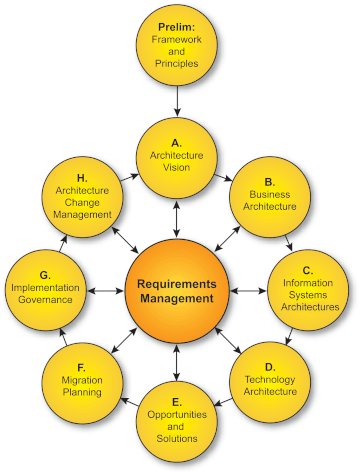Aligning Business and IT Strategies with TOGAF
Enterprise Architecture (EA) is a crucial tool for organizations that want to achieve their strategic vision and deliver tangible benefits. By providing a comprehensive roadmap, EA enables enterprise architects to bridge the gap between business and IT, ensuring that technology supports and enables the broader organizational goals. Enterprise Architecture (EA) is a crucial discipline that provides a roadmap for an organization’s vision, enabling enterprise architects to align business and IT strategies and deliver EA value and benefits. The Open Group Architecture Framework (TOGAF) is a widely adopted EA methodology that offers a proven and systematic approach to developing an EA roadmap aligned with the organizational vision.
The Open Group Architecture Framework (TOGAF) is a widely adopted EA methodology that can help organizations leverage the power of EA. TOGAF’s Architecture Development Method (ADM) outlines a structured approach to building an EA that is aligned with the enterprise’s vision and requirements.
The key to success with TOGAF is to follow the principles and guidance outlined in the framework. This includes:
- Aligning business and IT strategies: TOGAF’s ADM process starts with the Preliminary phase, where enterprise architects work to understand the organization’s strategic objectives, drivers, and constraints. This lays the foundation for developing an EA that supports the business.
- Taking an iterative, incremental approach: TOGAF’s ADM is designed to be a cyclical process, allowing enterprise architects to continuously refine and improve the EA as the organization’s needs evolve.
- Ensuring stakeholder engagement and buy-in: TOGAF emphasizes the importance of engaging with stakeholders throughout the EA development process, ensuring that the final solution meets their needs and has their support.
- Leveraging the TOGAF content framework: TOGAF provides a comprehensive content framework that describes the various architecture domains (business, data, application, and technology) and how they interrelate. This helps enterprise architects create a holistic, integrated EA.
TOGAF’s Architecture Development Method (ADM)
TOGAF’s Architecture Development Method (ADM) is a cyclical process that consists of eight phases, each with specific objectives and deliverables. The ADM process enables enterprise architects to create a comprehensive EA roadmap that is aligned with the organization’s strategic goals and objectives.

Here are some steps to get started with TOGAF and create an EA roadmap aligned with the organizational vision:
- Preliminary Phase: Define the Architecture Capability
The first step is to establish the architecture capability within the organization by defining the governance structure, roles, and responsibilities. This phase also involves identifying the stakeholders, their concerns, and expectations.
- Phase A: Architecture Vision
In this phase, the architects define the architecture vision, which aligns with the organization’s strategic goals and objectives. The architects identify the business drivers, define the scope, and develop the architecture principles, which guide the EA roadmap development.
- Phase B: Business Architecture
The business architecture phase focuses on modeling the organization’s business processes, information, and stakeholders. The architects define the business capabilities, organization structure, and information flows to support the architecture vision.
- Phase C: Information Systems Architecture
In this phase, the architects define the information systems architecture, including the applications, data, and technology infrastructure. The architects identify the gaps between the current and target architectures and develop a plan to address them.
- Phase D: Technology Architecture
The technology architecture phase defines the hardware, software, and network infrastructure required to support the information systems architecture. The architects identify the technology components, standards, and platforms needed to implement the target architecture.
- Phase E: Opportunities and Solutions
In this phase, the architects identify the opportunities and solutions to address the gaps identified in the previous phases. The architects evaluate the alternatives, select the preferred solutions, and develop a transition plan to implement the target architecture.
- Phase F: Migration Planning
The migration planning phase involves developing a detailed plan to implement the target architecture. The architects define the migration waves, sequence, and timing, considering the stakeholders’ concerns and expectations.
- Phase G: Implementation Governance
The implementation governance phase ensures that the EA roadmap is implemented following the defined governance structure, roles, and responsibilities. The architects monitor the implementation progress, manage the risks, and ensure that the benefits are realized.
- Phase H: Architecture Change Management
By following the TOGAF principles and the ADM process, enterprise architects can create an EA roadmap that is closely aligned with the organization’s overall vision and strategy. This, in turn, enables the delivery of tangible EA benefits, such as improved operational efficiency, better decision-making, and enhanced responsiveness to market changes. TOGAF is a powerful tool for enterprise architects who want to align their business and IT strategies and deliver the full value of EA to their organizations. By incorporating TOGAF’s best practices and leveraging its comprehensive framework, enterprises can embark on a successful EA journey and achieve their strategic objectives.
- Key Stakeholders in TOGAF: Who Drives Enterprise Architecture?
- Navigating Enterprise Excellence: A Practical Guide to TOGAF Implementation
- Chapter 31. TOGAF ADM Guide-Through
- Harmonizing Excellence: Integrating TOGAF with Leading Frameworks for Robust Enterprise Architecture
- Working with TOGAF ADM Guide-through
- TOGAF Guide-Through Process
- Step-by-Step Enterprise Architecture Tutorial with TOGAF
- Mastering TOGAF ADM with Visual Paradigm: A Comprehensive Guide
- Working with TOGAF ADM Guide-through

